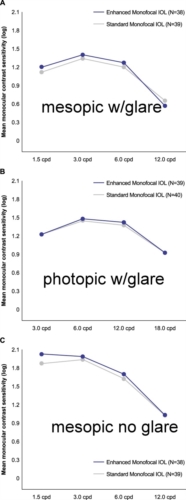Eyhance Contrast Sensitivity under Mesopic Conditions
Posted , 3 users are following.
Eyhance was found to be equivalent in contrast sensitivity to standard monofocal under both mesopic and photopic conditions. If you look at the curves, it's actually mostly better by a tiny bit. This confirms what many who have the Eyhance have posted regarding their subjective experience (good night vision).
Article: Clinical evaluation of a new monofocal IOL with enhanced intermediate function in patients with cataract (Google it)
"Monocular, corrected distance contrast sensitivity results at 6 months under mesopic and photopic conditions with glare for first eyes in subgroup patients are presented in Figure 3. Mean values for contrast sensitivity were similar between the enhanced monofocal IOL and standard monofocal IOL groups, and the differences between IOL groups were all within 0.15 log units for all the cycles per degree measured at both mesopic and photopic conditions with glare."
0 likes, 5 replies

RonAKA jimluck
Posted
The issue I have with claims by J&J on the Eyhance IOL is that they say the mild EDOF achieved is the result of it not being a pure single power monofocal. The power of the lens is varied from the center out to the pheriphery of the lens. For sure that will stretch or smear the point of focus and as a result give an extended depth of focus. However you can't do that without reducing contrast sensitivity. It is a tradeoff. You can't have your cake and eat it too. Seems to me if the contrast sensitivity loss is minor than the extension of depth of field is also minor. The lens may be a good choice for someone willing to give up a little to get a little. The Vivity in comparison gives up more contrast sensitivity and gains more depth of focus.
jimluck RonAKA
Posted
And yet, the empirical data say they have. Look at that 3rd graph: Eyhance contrast sensitivity equal or better at every point.
Maybe there's more to it than the simple 2-variable tradeoff you postulate.
This appears to be a journal article, reporting scientific research, not a J&J claim.
RonAKA jimluck
Edited
I believe Bausch + Lomb are most direct about the issue. They show a graph of visual acuity vs depth of focus (EDOF) for various amounts of asphericity. At zero asphericity all the light will reach the same focus point, but will have the minimum depth of focus. But, as you stretch out the point of focus visual acuity and contrast sensitivity drop. Their enVista lens does not strive to have the highest visual acuity, but it achieves a better depth of focus and tolerance to lens position. To me this graph illustrates that it is a trade off and there is no free lunch, just different priorities.
.
soks RonAKA
Posted
i am not arguing the physics but i think vivity is a completely different design with visible single diffraction. it seems with eyhance there is no visible diffractive ring. vivity is experiencing a lot more contrast loss and dysphotopsias but like you said it is gaining more near. i think eyhance is a smart design if you trust the defocus curves. they have assigned the light that gives better than 2020 in a monofocal to intermediate and without diffraction. ofcourse there will be contrast loss but is that noticeable?
RonAKA soks
Posted
I am afraid I am in the "there is no free lunch" group. If you stretch the focus point out to enhance depth of focus, there has to be a priced paid for it. I am not saying it is a bad idea, but there is a price for the extended depth of focus. B+L presents the case that it is a good trade off, and in practical terms they may be correct.